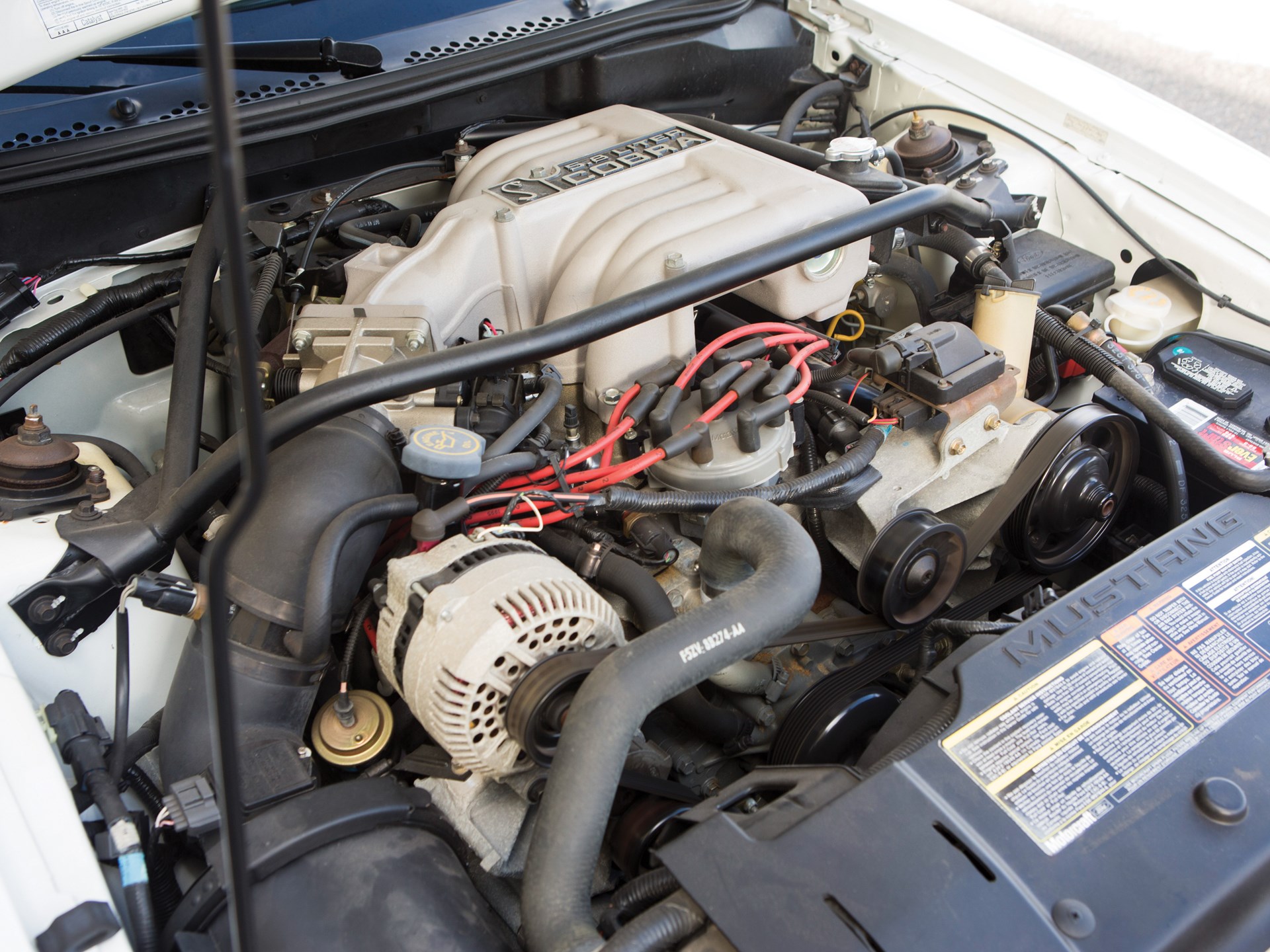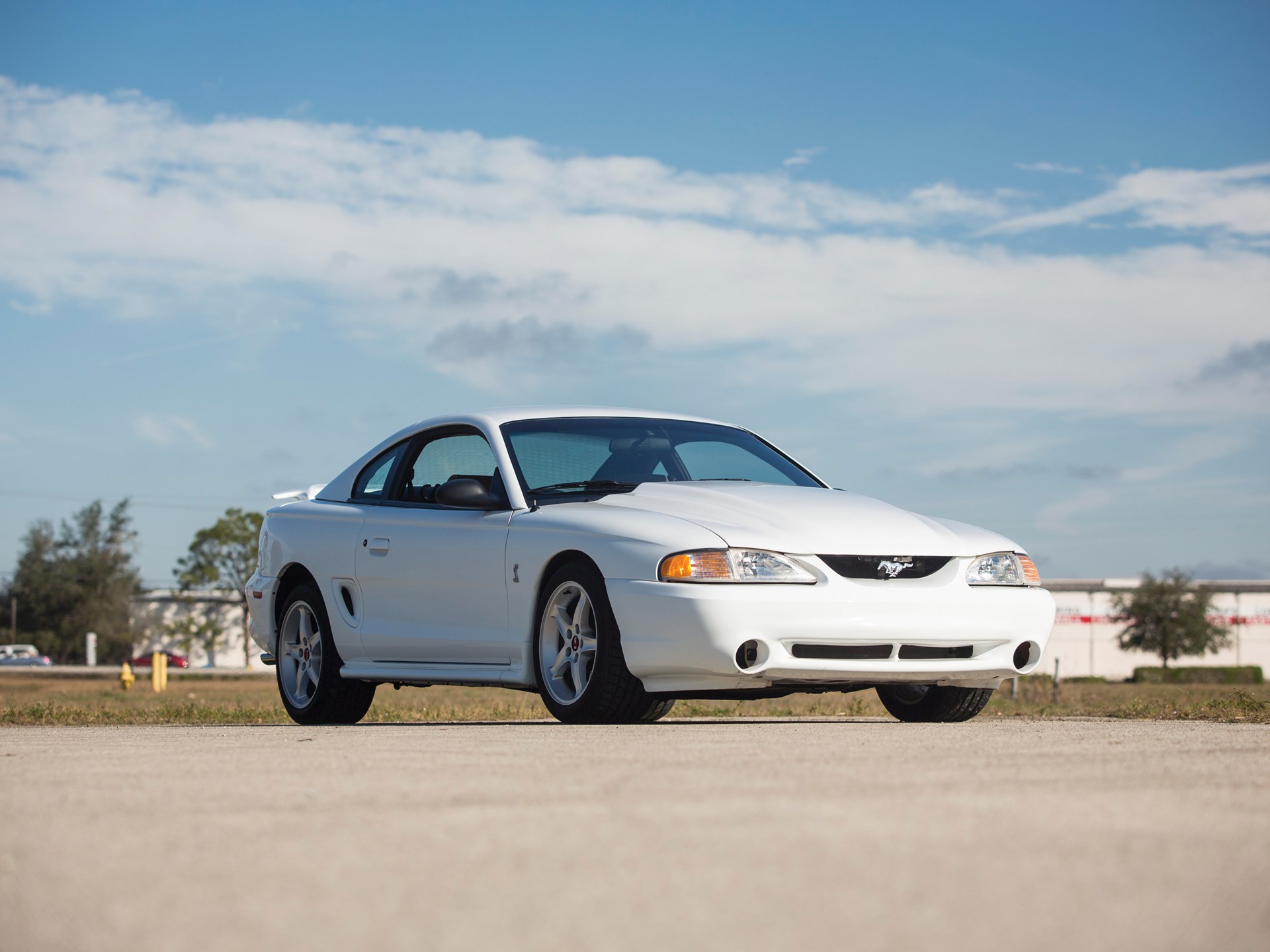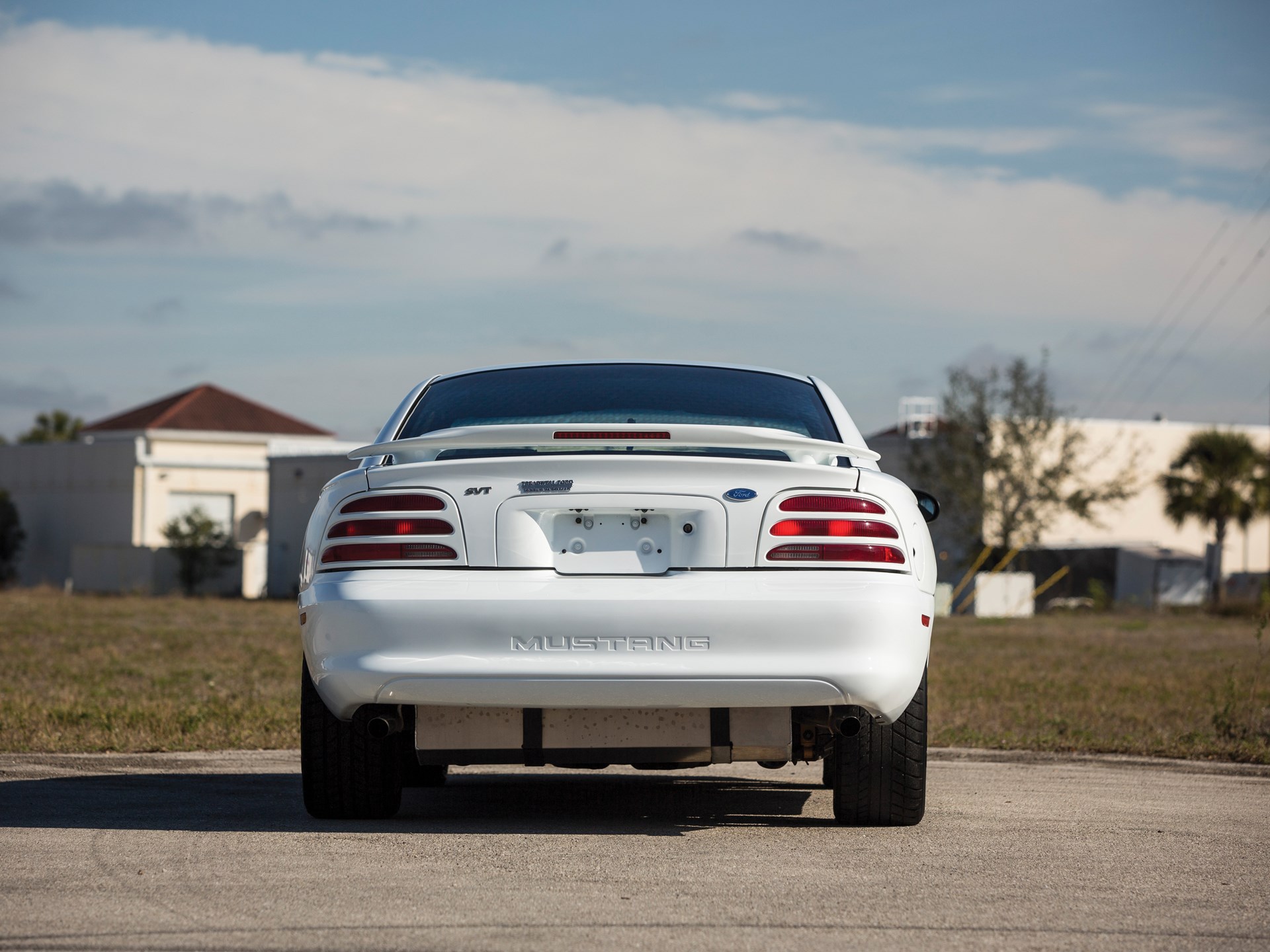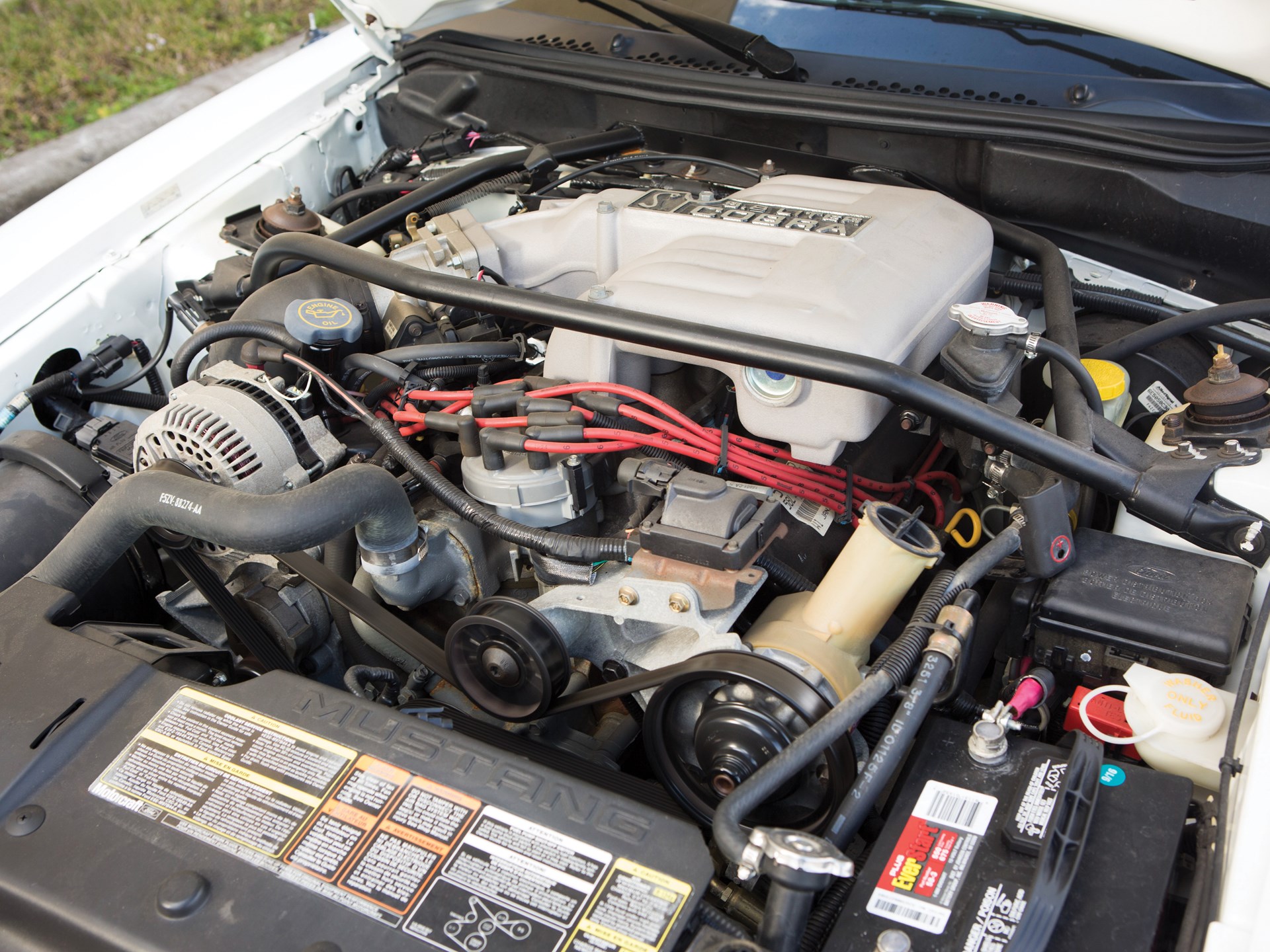Media | Articles
The 1995 Mustang SVT Cobra R is a track hero, but not an auction star
January 2019 will go down as a milestone in Mustang history. At the North American Auto Show in Detroit, Ford introduced the most powerful production Mustang ever—actually, the most powerful production Ford ever—the 2020 Shelby GT500 with 700+ horsepower.
The next day, Mecum’s Kissimmee (Florida) auction sold the one-and-only 1967 Shelby GT500 Super Snake, originally built for high-speed tire testing, for $2.2 million—the most ever paid for a Mustang at public auction. And only a few days later, at Barrett-Jackson’s Scottsdale auction, a 1993 Mustang SVT Cobra R that was never dealer-prepped or raced sold for $132,000—a record for a Fox-body Mustang.
In that context, it might be difficult to understand why the most powerful, fastest, rarest Mustang of 1995, the SVT Cobra R factory race special, can generally be had for less than its original MSRP (the highest recent sale we could find was $35K at Mecum Kissimmee in 2017). No doubt, original ’95 Cobra R owners who put away low-mile, non-raced cars for future value speculation might be feeling the burn. The $38,000 MSRP for a Cobra R (including shipping and $2100 gas guzzler tax) is the equivalent of around $63,000 today, or about $4000 north of a 2019 Shelby GT350.

“Fourth-gens in general just don’t seem to be getting strong prices yet, and for now this extends to the special performance models,” says Andrew Newton, Hagerty auction editor. “We cut fourth-gen Mustang values by a little over 10 percent pretty much across the board with our latest pricing update, and this includes all the SVT cars. A rare factory race special like this is likely to be quite collectible for Ford/Mustang folks, but people aren’t clamoring for one yet.”
Marketplace
Buy and sell classics with confidence
It’s not all about money. Without the constraints of meeting safety and emissions regulations, building a homologated, street-legal factory racer like the original Shelby GT350R was fairly easy in 1965. Doing something similar 30 years later posed a greater challenge. Whatever its price tag, the 1995 Cobra R deserves its proper due within the Mustang’s lineage.
Behind the “R”

Let’s start by stating what the 1995 SVT Cobra R was not. Despite its top-dog performance status in the 1995 Mustang family, the Cobra R was not built as a competitor to the Camaro Z28. The fact is, the fourth-gen Z28 introduced for 1993, powered by the 275-horse LT1 5.7-liter (350-cubic-inch) small-block V-8, simply overpowered the “Fox 4” Mustang GT (215 hp) and SVT Cobra (240 hp). To deal with that, Mustang buyers could turn to the vast aftermarket that supported Ford’s 5.0-liter (302-cu-in) Windsor engine.
Instead, the 1995 Cobra R was a factory racer in the manner of the ’65 Shelby GT350R, but still street legal with all emissions and safety equipment intact. Like the 1993 Cobra R, the ’95 model was stripped of its air conditioning, power windows, back seat, stereo, sound insulation, and other sundries. But then SVT added something no Mustang had offered since 1973: Instead of the Cobra’s 240-hp 5.0-liter small-block, the Cobra R got its bigger 5.8-liter brother, also known as the “351.”
It was based on the engine in the SVT Lightning pickup, but juiced with higher compression (9.1:1 versus 8.8), a more aggressive cam, and a larger-diameter air-meter body. The result was 300 horsepower and 365 lb-ft of torque for the Cobra R, more than any factory-issue small-block Mustang had offered before (in net terms). The fiberglass hood with center bulge was needed to clear the taller engine. Backing the beefy 351 was a Tremec 3550 five-speed in place of the Cobra’s Borg-Warner T5, with a 3.27:1 axle ratio versus 3.08.


The Fox 4 structure was sufficiently stronger compared to the original Fox that the only structural modification necessary for the ’95 Cobra R was a strut tower brace. (The ’93 also had under-car bracing from the Mustang convertible.) Stiffer, 700/850-pounds-per-inch progressive-rate front springs and adjustable Koni shocks were meant for track, not street, and a 30mm (1.18-in.) anti-roll bar replaced the Cobra’s 25-mm bar.
At the rear, the ’95 Cobra R used 200/260 lbs./in. progressive-rate coil springs and adjustable Koni shocks (vertical and horizontal). The 27-mm stabilizer anti-roll bar was from the street Cobra.
Vented disc brakes came from the Cobra—13-inch diameter up front and 11.65-inch in back—with front/rear adjustability added for the R. Deleting the Cobra’s fog lights provided intakes for brake cooling ducts. The 255/45ZR17 tire size was the same as the Cobra’s, but the R model came with BFGoodrich Comp T/A tires in place of the street model’s Goodyear GS-C tires, mounted on nine-inch rims.
Even with all the deleted pieces, the ’95 Cobra R still weighed in at 3326 pounds; the 351 engine, 20-gallon fuel cell, two-row radiator, and other items added some heft. The only warranty was the one required on the emissions equipment, which ended when racing prep started.
Limited production

A good number of the ’93 cars ended up in collectors’ hands and never saw track duty. For the ’95 SVT Cobra R, Ford would require buyers to either own a race team or have a racing license and show plans to compete in IMSA, SCCA, NHRA, or IHRA competition. Production was limited to 250 cars, but, despite Ford’s screening efforts, some ended up in collectors’ hands from the start.
All 250 cars were painted Crystal White and had the base Mustang cloth interior. That didn’t matter—you were going to pull that out for a race seat anyway, right? The whole bundle of mods was listed on the window sticker as a $13,699 “R Competition Option” over the Cobra. Ford said that all 250 cars sold out in five days, although some might have been dealer purchases.
The 1995 Cobra R’s performance only served to gnaw at Mustang buffs who were pining for a Z28 slayer. Motor Trend recorded 0–60 in 5.2 seconds, and the quarter-mile in 13.8 at 102 mph. The latter was one second and 6.6 mph better than a 5.0-liter Cobra, and a couple of tenths ahead of the fully street-equipped Z28. Car and Driver got a 151-mph top speed, a few mph below the Z28 with its optional Z-rated tires.

The Cobra R delivered on the promise of track handling, blasting through Motor Trend’s 600-foot slalom “with little drama” and posting a 67.4-mph average speed (1.1 mph faster than a 1995 Porsche 911, according to the magazine) while generating 0.96 g. In 1995, that was flying, especially for a car whose basic platform was engineered in the 1970s for the Ford Fairmont.
As Fox-based Mustangs go, the ’95 Cobra R bridged the gap between the 5.0-liter cars and the Modular cammers that followed. It may always be in the shadow of the far-fiercer 2000 Cobra R, but its critical role in the Mustang’s performance evolution and race heritage can never be disputed.







